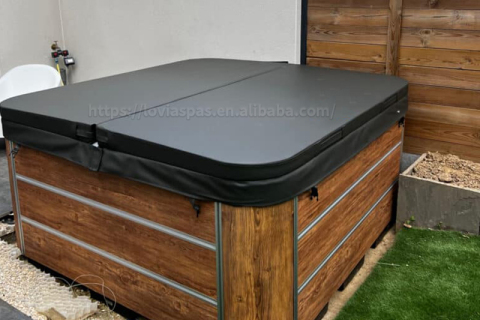
- Home
- >
News
A hot tub cover lifter is an auxiliary device used to simplify the operation of a hot tub cover. Most hot tub covers are heavy and are usually made of heavy foam materials to retain heat and maintain water quality.
The water temperature of 38℃ to 40℃ is considered to be the most suitable temperature range for promoting blood circulation. At this temperature, blood vessels dilate and blood can flow to the limbs and muscles faster, thereby accelerating the discharge of metabolic waste (such as lactic acid) and delivering nutrients to damaged muscle parts.
Hot water can dilate blood vessels and promote blood circulation. For people with sciatica, improved blood circulation can provide more oxygen and nutrients to the nerves and compressed areas, accelerating the healing process. Good blood circulation also helps reduce inflammation, further reducing pain and discomfort.
wooden decks are generally required to be designed to withstand a load of approximately 300 to 500 pounds (approximately 136 to 227 kilograms) per square foot. This means that the average weight distribution of a hot tub with an area of 2.5 square meters will fall between approximately 120 and 180 kilograms per square foot, which is already beyond the load-bearing standard of ordinary decks.
Symptoms of a broken hot tub heater: 1. The water temperature does not rise or is erratic 2. Abnormal temperature display 3. No noise or abnormal noise from the heater 4. Tripping or power outage 5. Abnormal water quality
Hot tub stabilizers, as the name suggests, are devices that help maintain the chemical balance in water. Generally, the function of stabilizers is mainly focused on regulating the concentration of chlorine and other disinfectants in water to ensure water quality safety and prevent the growth of harmful microorganisms.
The fastest way to cool down a hot tub: 1. Turn off the heater and heating function 2. Refill the tub with cold water 3. Use a cooling device or ice cubes 4. Maintain good water circulation 5. Cover or avoid direct sunlight 6. Use fans or air circulation to speed up cooling
Prolonged exposure to hot water can damage the stratum corneum, the skin's natural barrier. Hot water dissolves the natural oils on the skin's surface, damaging the skin's moisture barrier. This causes water to drain quickly from the skin, leaving it dry, tight, and even cracked. This dryness may be accompanied by itching and tingling, especially in people with sensitive skin.
When the jets are turned on, there should be a strong and continuous flow. The force of the water jets should be evenly distributed, and the flow strength of each jet should be similar, without obvious weakening or intermittent flow.
Benefits of soaking in an outdoor hot tub in winter: 1. Promote blood circulation 2. Soothe muscles and joints 3. Enhance immune function 4. Improve mental health 5. Improve sleep quality Potential risks of soaking in an outdoor hot tub on a snowy day: 1. Risks caused by body temperature fluctuations 2. Risk of dehydration 3. Equipment maintenance and frost damage 4. Risk of accidental slips 5. Risk of body exposure to cold air
If you plan to not use the tub in the winter, it is recommended to drain the water completely to prevent the water from freezing in the cold environment. After draining the water, wipe the inside and outside surfaces of the tub with a mild detergent to remove dirt and mineral deposits.
Yes, hot tub disinfectants are still essential. Although ozone can kill a large number of bacteria and viruses, its short duration of action limits its protective effect. Recommended disinfectants are: chlorine and bromine.












